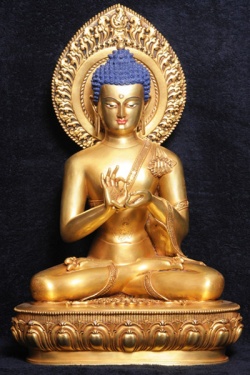Difference between revisions of "Nimitta"
(Created page with "thumb|250px| <poem> 'Nimitta': mark, sign; image; target, object; cause, condition. These meanings are used in, and adapted to, ...") |
|||
| Line 3: | Line 3: | ||
'[[Nimitta]]': [[mark]], [[sign]]; [[image]]; [[target]], [[object]]; [[cause]], condition. These meanings are used in, and adapted to, many contexts of which only the doctrinal ones are mentioned here. | '[[Nimitta]]': [[mark]], [[sign]]; [[image]]; [[target]], [[object]]; [[cause]], condition. These meanings are used in, and adapted to, many contexts of which only the doctrinal ones are mentioned here. | ||
| − | 1. '[[Mental]] (reflex-) [[image]]', obtained in [[meditation]]. In full clarity, it will appear in the [[mind]] by successful practice of certain [[concentration]]-exercises and will then appear as {{Wiki|vividly}} as if seen by the {{Wiki|eye}}. The [[object]] perceived at the very beginning of concentration is called the [[preparatory image]] ([[parikamma-nimitta]]). The still unsteady and unclear image, which arises when the [[mind]] has reached a weak degree of [[concentration]], is called the [[acquired image]] ([[uggaha-nimitta]]). An entirely clear and immovable image arising at a higher degree of concentration is the [[counter-image]] ( | + | 1. '[[Mental]] (reflex-) [[image]]', obtained in [[meditation]]. In full clarity, it will appear in the [[mind]] by successful practice of certain [[concentration]]-exercises and will then appear as {{Wiki|vividly}} as if seen by the {{Wiki|eye}}. The [[object]] perceived at the very beginning of concentration is called the [[preparatory image]] ([[parikamma-nimitta]]). The still unsteady and unclear image, which arises when the [[mind]] has reached a weak degree of [[concentration]], is called the [[acquired image]] ([[uggaha-nimitta]]). An entirely clear and immovable image arising at a higher degree of concentration is the [[counter-image]] ([[paṭibhāga-nimitta]]). As soon as this image arises, the stage of neighbourhood (or access) concentration ([[upacāra-samādhi]]) is reached. |
| − | 2. 'Sign of (previous) [[kamma]]' ([[kamma-nimitta]]) and 'sign of | + | 2. 'Sign of (previous) [[kamma]]' ([[kamma-nimitta]]) and '[[sign of the future) destiny]]' ([[gati-nimitta]]); these arise as [[mental]] [[objects]] of the last [[karmic]] [[consciousness]] before [[death]] ([[maraṇ]]'''''[[āsanna]]''''' [[kamma]]. |
Usages (1) and (2) are commentarial (s. App.). In [[Sutta]] usage, the term occurs, e.g. as: | Usages (1) and (2) are commentarial (s. App.). In [[Sutta]] usage, the term occurs, e.g. as: | ||
Revision as of 07:35, 9 August 2013
'Nimitta': mark, sign; image; target, object; cause, condition. These meanings are used in, and adapted to, many contexts of which only the doctrinal ones are mentioned here.
1. 'Mental (reflex-) image', obtained in meditation. In full clarity, it will appear in the mind by successful practice of certain concentration-exercises and will then appear as vividly as if seen by the eye. The object perceived at the very beginning of concentration is called the preparatory image (parikamma-nimitta). The still unsteady and unclear image, which arises when the mind has reached a weak degree of concentration, is called the acquired image (uggaha-nimitta). An entirely clear and immovable image arising at a higher degree of concentration is the counter-image (paṭibhāga-nimitta). As soon as this image arises, the stage of neighbourhood (or access) concentration (upacāra-samādhi) is reached.
2. 'Sign of (previous) kamma' (kamma-nimitta) and 'sign of the future) destiny' (gati-nimitta); these arise as mental objects of the last karmic consciousness before death (maraṇāsanna kamma.
Usages (1) and (2) are commentarial (s. App.). In Sutta usage, the term occurs, e.g. as:
3. 'Outward appearance': of one who has sense-control it is said- that "he does not seize upon the general appearance' of an object ('na' nimittaggāhī; M. 38, D. 2; expl. Vis I, 54f;
4. 'Object': the six objects, i.e. visual, etc. (rūpa-nimitta; S. XXII, 3). Also, when in explanation of animitta -cetovimutti, signless deliverance of mind (s. cetovimutti, vimokkha), it is said, 'sabbanimittānaṃ amanasikārā', it refers to the 6 sense-objects (Com. to M. 43 [Saḷ'āyatanavagga-a'ṭṭ'hakathā]), and has therefore to be rendered "by paying no attention to any object (or object-ideas)." - A pleasant or beautiful object (subha-nimitta, q.v.) is a condition to the arising of the hindrance of sense-desire; a 'repellent object' (paṭigha-nimitta) for the hindrance of ill-will; contemplation on the impurity of an object (asubha-nimitta; s. asubha) is an antidote to sense-desire.
5. In Pts.M. II, in a repetitive series of terms, nimitta appears together with uppādo (origin of existence), pavattaṃ (continuity of existence), and may then be rendered by 'condition of existence' (s. Path, 194f.).
